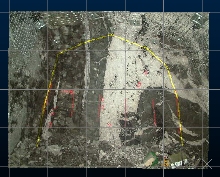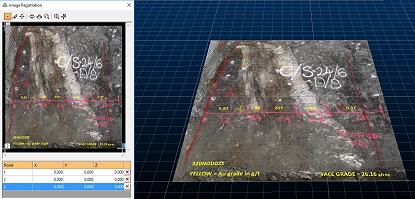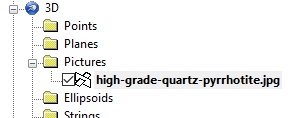|
|
Pictures Data Type Using the Images data type |
Pictures Data Type

The Pictures data type represents image objects within your 3D windows. The objects are standalone planar image objects, not to be confused with textured wireframes.
Displayed on a flat plane, oriented in any 3D direction, picture objects are useful references for further analysis and design. You can either use existing georeferencing data or configure your own at the point of loading.
Pictures data files will appear in the Project Files and Project Data control bars (if your product supports them). Once loaded, objects will appear in the Loaded Data control bar and overlays can be seen in the Sheets and Project Data control bars (again, only if your product includes these tools).
You can export Pictures objects using any of Studio's export options.
An image object is represented by a Datamine database which describes the location of a raster image plus its georeferenced position in 3D world coordinates.
There are two ways a Datamine picture table can store the location of a raster image:
- As an absolute location on disk (the fully-qualified path to the location of the image file).
- As the image file name only (if the table and image were exported/saved to the same location).
Loading the Datamine file will automatically load the image data onto a flat plane in 3D, at the most recent georeferenced coordinates.

3D Registration Dialog
and Georeferenced Image
Images do not have to be previously georeferenced to be referenced by Datamine Image objects; if no georeferencing information is available at the time the raw image is loaded (e.g. the image is not supported by a .bmpx, .pngx etc. partner file, or contains no georeferenced metadata) you can define your own georeferencing coordinates using the Image Registration dialog.
Pictures data object have 3D
formatting options and Sheets
control bar options.
|
|
If your loaded image contains an alpha channel it will be honoured, meaning transparent or partially-transparent textures will be supported. You can choose to make all black pixels (RGB=0,0,0) transparent, even if your image doesn't support transparency. |
Loading an Image
You can create a pictures data object by first loading the image, then (if required) georeferencing it by mapping local and world 3D points.
You load an image by either:
- dragging and dropping a recognized image type into any active 3D window
- enabling the Data ribbon and selecting Load | Datamine | Pictures
- enabling the Data ribbon and selecting Load | External | Image
- enabling the Project Files control bar and choosing Load External Data into the Project, then selecting the appropriate driver and file. You can then load the file (found in the Image Files folder).
- enabling the Project Files control bar and choosing Add Existing Files to Project, then locating an image. You can then load the file (found in the Image Files folder).
Creating a Picture Object or File

Once loaded, the image will either be displayed according to its existing world coordinates or, if no georeferencing data is available, you will be shown the Image Registration dialog to set up a minimum of 3 points on both the image and in 3D space. The image will be resized and oriented to match the digitized coordinates.
A Picture data object will also be created, containing the information needed to locate and orient the image data. This will appear in other control bars within your application, such as Sheets, Project Data and Project Files.
Once a picture object exists in memory, you can save a picture object as either a Datamine or other file via Data Source Drivers.


